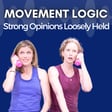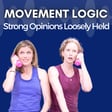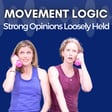
55: How to Start (and Teach) Strength Training
Welcome to Episode 55 of the Movement Logic podcast. In this episode, Laurel answers two questions that she gets regularly from folks online. They are: How can I get started with strength training? And, how can I “learn more about” strength training? Spoiler: the best way to get started with strength training (the doing and the teaching) is by…wait for it…strength training!
In this episode you will learn:
- The three most important elements of strength training—exercise technique, programming, and coaching.
- Why yoga and Pilates teachers are already generally well-versed in exercise technique, but without the added component of external load and the goal of strength.
- Yoga and Pilates teachers are typically not well-versed in programming, which is how we apply the principle of progressive overload to work toward building strength.
- Coaching is key for deep understanding of both exercise technique and programming.
- Laurel’s evolution from teaching yoga to becoming a strength coach.
- The plusses, minuses and trade-offs of DIY program templates, group classes, one-on-ones, and more.
- How yoga and Pilates teachers are accustomed to learning in a live, follow along format, and given then, how it can be a rude awakening to discover that programs in strength are often delivered in PDF format and personal trainer certifications mostly ask you to read a textbook and pass a test.
- Why personal trainer certifications do not provide very much practical know-how for how to be a personal trainer.
- How the Bone Density Course: Lift for Longevity delivers on the three most important elements of getting started with strength and learning about strength training—exercise technique, programming, and coaching.
- How the CSCS is widely considered the gold standard of personal trainer certifications but that it almost exclusively caters to competitive athletes (who make up a fraction of people who resistance train.)
- How being a dedicated student of the thing you eventually want to teach is the most valuable way to prepare yourself to actually teach something.
- How strength is defined, the systems in the body involved, and what the main adaptations (or changes) to your body are when you build strength.
- That we can be strong in many ways,so it’s helpful to have a specific performance goal.
- Why specific, performance goals are the best way to reach health and aesthetic goals.
Sign up for our free info session all about our Bone Density Course: Lift for Longevity Thursday, Sep. 22nd 12 PT/ 3 ET
Sign up for our Bone Density Course: Lift for Longevity before the October 8th deadline! We won’t be offering this for another year.
The NSCA textbook is used to study for the CSCS - Essentials of Strength and Conditioning
Effect of Online Home-Based Resistance Exercise Training on Physical Fitness, Depression, Stress…
Association of Efficacy of Resistance Exercise Training With Depressive Symptoms…


